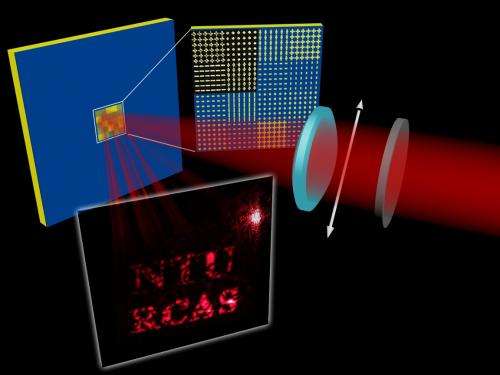January 9, 2014 feature
Meta-hologram produces dual images and multiple colors (w/ Video)

(Phys.org) —Holograms have attracted wide attention for their ability to produce a realistic 3D image of an object by recording the object's light field and later reconstructing the light field on a 2D surface. Now researchers have fabricated a hologram using metamaterials that can produce dual holographic images of different colors on a single surface. The two images are generated by two orthogonal polarizations, while the colors are produced by the hologram's wide operation wave length range.
The researchers, Wei Ting Chen, et al., from institutions in Taiwan, the US, China, and Singapore, have published a paper on the meta-hologram in a recent issue of Nano Letters.
The researchers explain that current hologram technology is limited by the materials, which work only in a small region of the electromagnetic spectrum. Recently, researchers have turned to metamaterials, artificially constructed materials with subwavelength structures, to create holograms because they operate over a wider range of frequencies. However, metamaterials are bulky, which means light has to travel a long distance through them. Much of the light is absorbed, resulting in low efficiencies for image reconstructions.
Here, the researchers have fabricated a hologram based on a subcategory of metamaterials called metasurfaces, which are 2D and therefore thinner than typical 3D metamaterials. The resulting meta-holograms have the highest efficiency, 18% (defined as the total power of the reconstructed image divided by the power of the incident laser), of any hologram made using metamaterials to date.
The meta-hologram consists of many tiny gold nanocrosses. Each pixel in the 100 x 100-pixel meta-hologram is constructed with a 6 x 6 array of gold nanorods, and the nanorod pixels of the second image are turned perpendicular to the first, resulting in a 6 x 6 array of gold nanocrosses. Since the length of each nanorod determines the phase of the light waves, the researchers constructed nanorods of four different lengths, yielding 16 combinations, to achieve four phases. The design demonstrates that tuning the geometric parameters of the metasurface allows the phase of the electromagnetic waves to be modulated over a wide frequency range.
"With a wide operation wavelength range, the hologram has high potential as a full-color hologram," coauthor Din Ping Tsai, Director of the Research Center for Applied Sciences at Academia Sinica in Taipei, Taiwan, told Phys.org. Tsai is also a physics professor at National Taiwan University in Taipei, Taiwan.
"The two images are generated by two orthogonal polarizations. Therefore, we simply designed the images of one object with two different viewing angles under the illumination of two orthogonal polarizations. The images will become 3D as the viewer wears conventional polarization 3D glasses. This design increases the amount of information stored in our proposed hologram, since the information can be read out by a pair of perpendicularly polarized incident waves, which is very useful for display and data storage."
To demonstrate the meta-hologram, the researchers reconstructed the images "NTU" (National Taiwan University in Taipei, Taiwan) and "RCAS" (Research Center for Applied Sciences at Academia Sinica in Taipei, Taiwan), originally taken by a CCD camera under x- and y-polarized light, respectively. They could reconstruct the images using different wavelengths of light, demonstrating the broadband functionality of the meta-hologram. As shown in the videos, the images can be reconstructed individually by controlled the polarization of the lasers. Moreover, the images can also be reconstructed by an incoherent light source.
The researchers expect that the efficiency of the meta-hologram can be further improved by using more than four different lengths of nanorods to increase the number of phase levels.
"Our future research plan is to develop a hologram with RGB colors and active phase-controlled devices with a switching frequency that is much larger than that of a spatial light modulator," Tsai said.
More information: Wei Ting Chen, et al. "High-Efficiency Broadband Meta-Hologram with Polarization-Controlled Dual Images." Nano Letters. DOI: 10.1021/nl403811d
Journal information: Nano Letters
© 2014 Phys.org. All rights reserved.





















